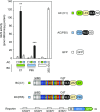Split-TALE: A TALE-Based Two-Component System for Synthetic Biology Applications in Planta
- PMID: 30643014
- PMCID: PMC6393785
- DOI: 10.1104/pp.18.01218
Split-TALE: A TALE-Based Two-Component System for Synthetic Biology Applications in Planta
Abstract
Transcription activator-like effectors (TALEs) are bacterial Type-III effector proteins from phytopathogenic Xanthomonas species that act as transcription factors in plants. The modular DNA-binding domain of TALEs can be reprogrammed to target nearly any DNA sequence. Here, we designed and optimized a two-component AND-gate system for synthetic circuits in plants based on TALEs. In this system, named split-TALE (sTALE), the TALE DNA binding domain and the transcription activation domain are separated and each fused to protein interacting domains. Physical interaction of interacting domains leads to TALE-reconstitution and can be monitored by reporter gene induction. This setup was used for optimization of the sTALE scaffolds, which result in an AND-gate system with an improved signal-to-noise ratio. We also provide a toolkit of ready-to-use vectors and single modules compatible with Golden Gate cloning and MoClo syntax. In addition to its implementation in synthetic regulatory circuits, the sTALE system allows the analysis of protein-protein interactions in planta.
© 2019 American Society of Plant Biologists. All Rights Reserved.
Figures







References
-
- Barrero AF, Alvarez-Manzaneda EJ, Altarejos J, Salido S, Ramos JM (1993) Synthesis of Ambrox(R) from (-)-Sclareol and (+)-Cis-Abienol. Tetrahedron 49: 10405–10412
-
- Bell CE, Frescura P, Hochschild A, Lewis M (2000) Crystal structure of the lambda repressor C-terminal domain provides a model for cooperative operator binding. Cell 101: 801–811 - PubMed
-
- Boch J, Bonas U (2010) Xanthomonas AvrBs3 family-type III effectors: Discovery and function. Annu Rev Phytopathol 48: 419–436 - PubMed
-
- Boch J, Scholze H, Schornack S, Landgraf A, Hahn S, Kay S, Lahaye T, Nickstadt A, Bonas U (2009) Breaking the code of DNA binding specificity of TAL-type III effectors. Science 326: 1509–1512 - PubMed
Publication types
MeSH terms
Substances
LinkOut - more resources
Full Text Sources
Other Literature Sources

